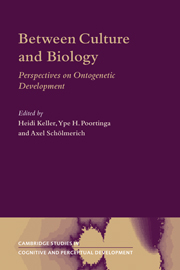Book contents
- Frontmatter
- Contents
- List of figures
- List of tables
- Notes on contributors
- Acknowledgements
- Introduction
- Part I Setting the scene
- 1 Culture, biology and development across history
- 2 Comparative developmental perspectives on culture: the great apes
- 3 The mutual definition of culture and biology in development
- Part II Perspectives on development informed by culture
- Part III Perspectives on development drawing from the universal and the specific
- Part IV Perspectives on development informed by evolutionary thinking
- Part V Metaperspectives
- Author index
- Subject index
- Cambridge Cultural Social Studies
2 - Comparative developmental perspectives on culture: the great apes
Published online by Cambridge University Press: 22 September 2009
- Frontmatter
- Contents
- List of figures
- List of tables
- Notes on contributors
- Acknowledgements
- Introduction
- Part I Setting the scene
- 1 Culture, biology and development across history
- 2 Comparative developmental perspectives on culture: the great apes
- 3 The mutual definition of culture and biology in development
- Part II Perspectives on development informed by culture
- Part III Perspectives on development drawing from the universal and the specific
- Part IV Perspectives on development informed by evolutionary thinking
- Part V Metaperspectives
- Author index
- Subject index
- Cambridge Cultural Social Studies
Summary
Interest in nonhuman primate culture owes primarily to the promise of insights into human culture, given the likelihood that evolutionary continuities link human and nonhuman primate processes. Concepts of human culture cannot be applied directly to nonhuman primates, however, because nonhuman primates do not share all the capacities counted as intrinsic to human culture. To enable comparative study, primatologists have focused on what is considered to be the basic defining feature of culture: social transfer of expertise operating across generations, at the group level (e.g. Kummer, 1971; McGrew, 1998; Nishida, 1987). Features considered beyond the reach of nonhuman primates are necessarily treated as secondary.
Defined this way, culture should feature in primate lives because primates characteristically rely on intricate forms of sociality for survival (e.g. Humphrey, 1976; Jolly, 1966; Smuts et al., 1987) and on lifelong learning for much of their expertise (e.g. Fobes and King, 1982; King, 1994; Parker and Gibson, 1990). Within nonhuman primates, the great apes have special importance as humans' sister species. Together, great apes and humans form a clade that diverged from other primates as recently as 16–19 million years ago (Groves, 1989; Pilbeam, 1996). That makes the great apes the closest living genealogical relatives to humans and, on that basis, the species most likely to resemble humans culturally. In that role, great apes are the focus of this chapter.
- Type
- Chapter
- Information
- Between Culture and BiologyPerspectives on Ontogenetic Development, pp. 30 - 56Publisher: Cambridge University PressPrint publication year: 2002
- 3
- Cited by



